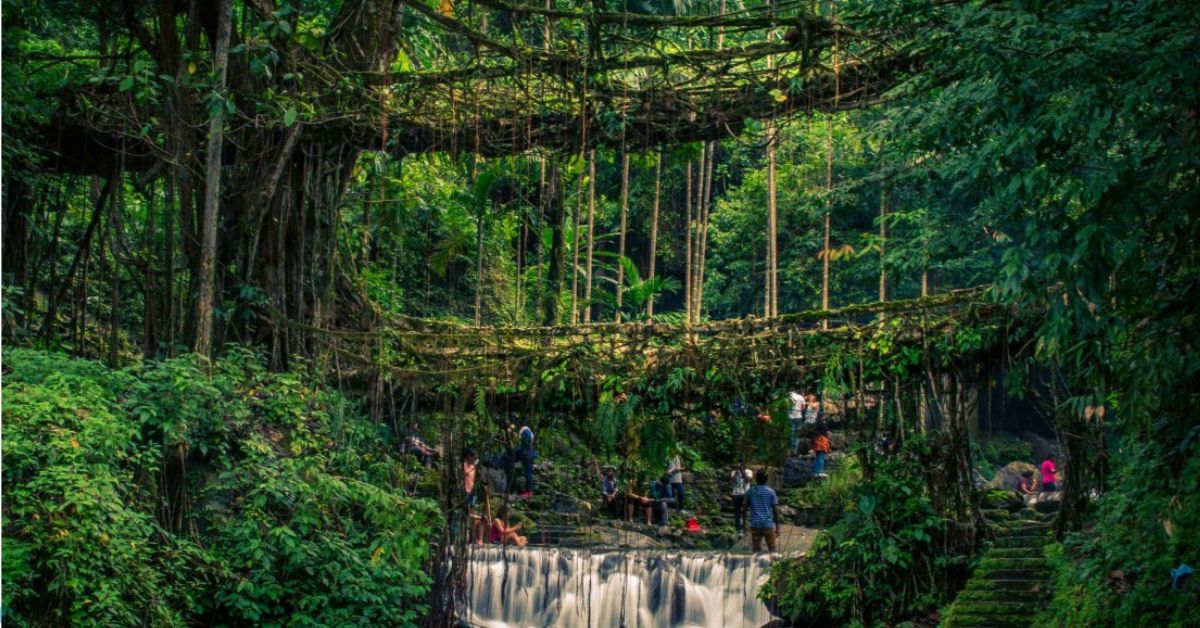Nestled amidst Meghalaya’s lush greenery, the Double-Decker Living Root Bridge stands as a living testament to the Khasi people’s profound connection with nature. This extraordinary structure, found in the village of Nongriat, is more than just a bridge; it’s a breathing, growing masterpiece crafted from the roots of ancient rubber trees. Spanning a picturesque river, this natural wonder embodies sustainable engineering at its finest, offering a captivating blend of adventure, history, and unparalleled beauty.
Reaching the Double-Decker Living Root Bridge is a journey in itself. Trekkers are rewarded with breathtaking vistas of cascading waterfalls, serene villages, and dense forests. The bridge, with its two tiers of intertwined roots, is a sight to behold, captivating the hearts of adventurers and nature lovers alike.
How to reach:
Air Travel: The nearest airport with significant connectivity is Lokpriya Gopinath Bordoloi International Airport in Guwahati, Assam, approximately 170 kilometers from Shillong. While Shillong’s Umroi Airport is closer, it has limited flight options. From either airport, you can hire a taxi or take a bus to reach Shillong.
Train Travel: Guwahati Railway Station is the most convenient railhead, around 100 kilometers from Shillong. It’s well-connected to major Indian cities. Taxis or shared cabs are readily available for the onward journey to Shillong.
Road Travel: Shillong serves as the base for exploring the region. From there, Cherrapunji (Sohra), about 54 kilometers away, is the gateway to the various root bridges, including the renowned Double-Decker Living Root Bridge. Taxis or shared cabs can be hired for this leg of the journey.
Best time to visit:
October to April:
This period offers the most pleasant weather for exploring Meghalaya. With temperatures ranging from 10°C to 25°C, clear skies, and lush green surroundings, it’s the perfect time to embark on the trek to the Double-Decker Living Root Bridge.
December to February:
The winter months bring a cool and crisp climate, making the trek comfortable. Additionally, you might have the chance to experience local festivals and cultural events, enriching your journey.
June to September:
While the monsoon transforms the landscape into a vibrant green paradise with cascading waterfalls, it also brings heavy rainfall. If you’re an adventure enthusiast who doesn’t mind getting wet, this season offers a unique experience. However, be prepared for challenging trekking conditions.
Double-Decker Living Root Bridge
Nestled amidst the lush greenery of Meghalaya’s Khasi Hills, the Double-Decker Living Root Bridge stands as a testament to the extraordinary harmony between humans and nature. This architectural wonder is not crafted from stone or steel, but from the living roots of ancient rubber trees, meticulously trained over centuries to form a sturdy, double-layered bridge.

A masterpiece of indigenous engineering, the bridge serves as a vital lifeline for locals and an awe-inspiring spectacle for visitors. Its unique two-tiered design is a practical adaptation to the region’s monsoon-laden rivers, offering safe passage even during the heaviest rains.
Nearby Attractions:
Rainbow Falls:
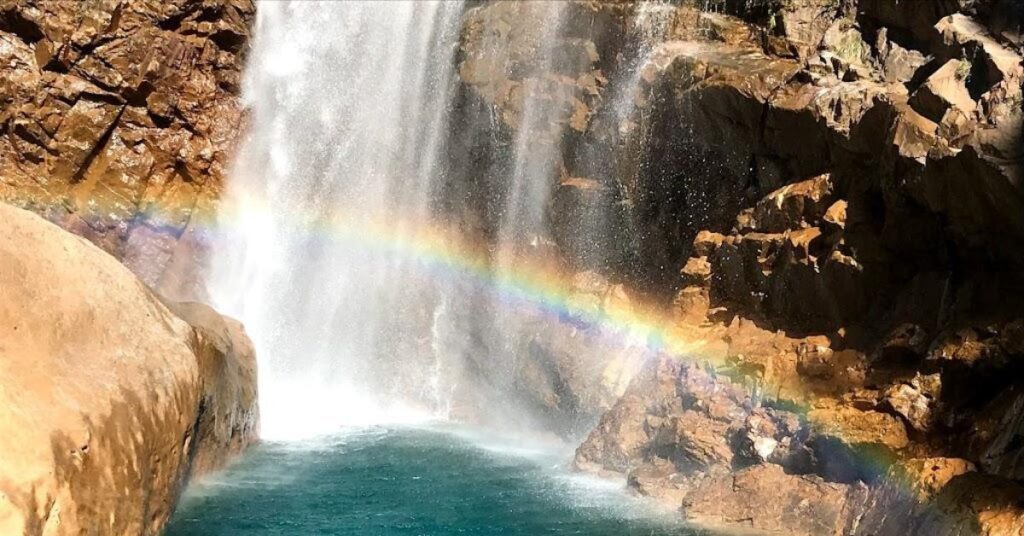
Hidden within a few hours’ trek from the Double-Decker Living Root Bridge, Rainbow Falls is a breathtaking natural spectacle. This serene retreat captivates visitors with its stunning beauty and the enchanting rainbows that often dance in its mist. The journey to the falls is an adventure through lush forests, crossing babbling brooks and following paths that offer breathtaking views. Along the way, vibrant flora and fauna create a verdant canopy, shading trekkers from the sun.
Finally, the falls reveal themselves – crystal-clear water cascading down rugged cliffs into a pristine pool below. The rainbows that appear in the mist add a magical touch to this already mesmerizing scene.
Single-Decker Living Root Bridges:
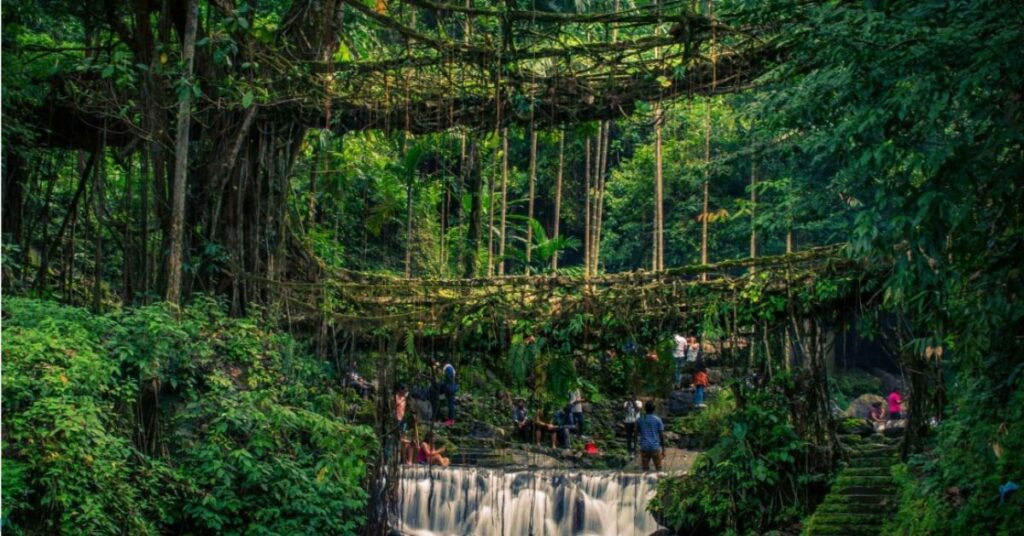
Meghalaya’s natural wonders extend beyond the famous Double-Decker Living Root Bridge. The region is also home to numerous single-decker living root bridges, each a testament to the Khasi tribe’s incredible ingenuity and nature’s resilience. These bridges, crafted from the roots of Ficus elastica trees, are sturdy, reliable crossings over rivers and streams.
Nongriat Village:
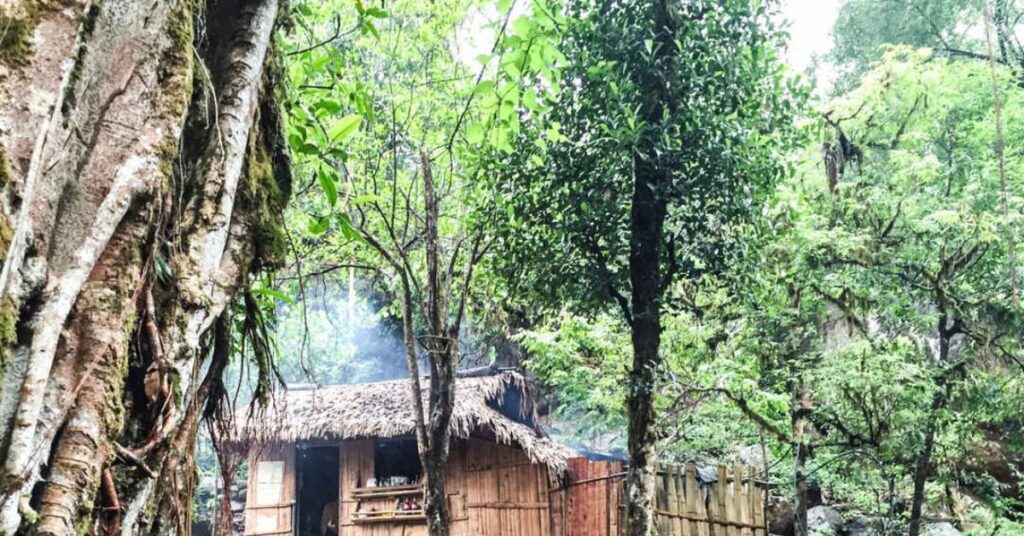
Nongriat Village, a serene haven nestled deep in Meghalaya, offers a glimpse into the traditional Khasi way of life. Reaching this remote village requires a challenging trek, but the journey is rewarded with breathtaking forests, cascading waterfalls, and diverse wildlife.
The village itself is charming, with traditional Khasi houses dotting the landscape and friendly locals welcoming visitors. Spending a night in Nongriat provides an immersive experience, allowing you to learn about local customs, cuisine, and lifestyle. As the home of the famous Double-Decker Living Root Bridge, Nongriat is also a convenient base for exploring this natural wonder.
Mawsmai Cave:
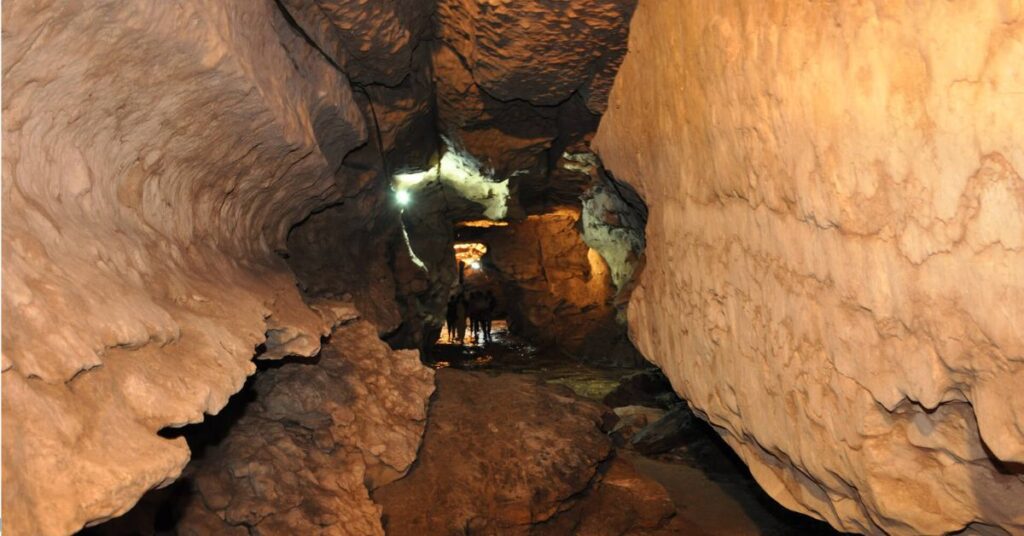
Mawsmai Cave, a popular attraction near Cherrapunji, offers a fascinating journey into the heart of Meghalaya’s limestone formations. Well-lit and easily accessible, this cave system is a thrilling adventure for visitors of all ages.
As you venture inside, the cool, damp air envelops you, and the intricate beauty of stalactites and stalagmites unfolds. These stunning formations, shaped over millennia, create a surreal and otherworldly atmosphere. The cave’s chambers vary in size, offering a sense of exploration and discovery as you navigate through its twists and turns.
Cherrapunji (Sohra):
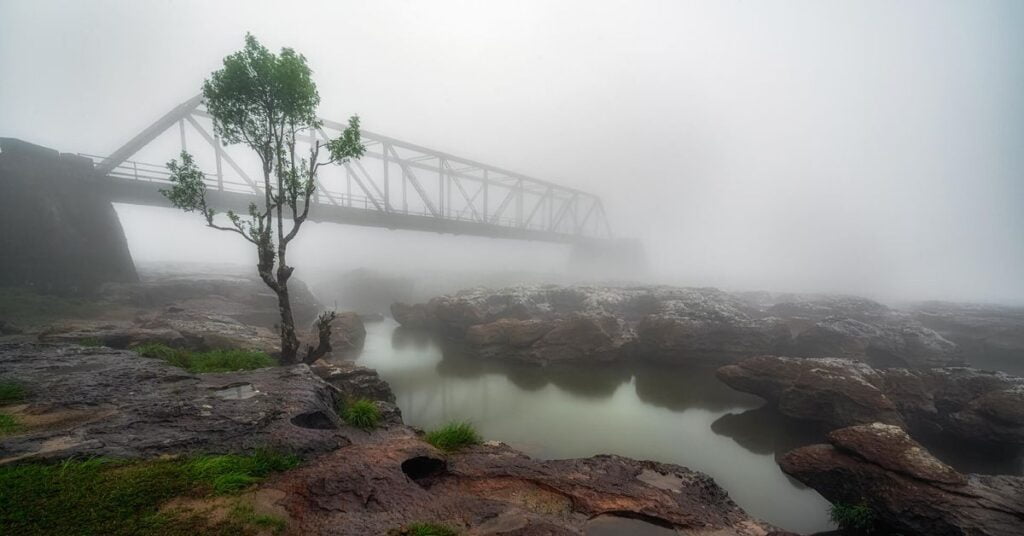
Cherrapunji, or Sohra as the locals call it, is renowned as one of the wettest places on Earth. This charming Meghalayan town is celebrated for its unique climate, abundant rainfall, and breathtaking landscapes. The journey to Cherrapunji itself is a visual treat, with rolling hills, deep gorges, and lush valleys unfolding before your eyes.
Once there, you’re greeted by a treasure trove of natural wonders: majestic waterfalls, expansive caves, and the iconic living root bridges. Cherrapunji’s rich history and culture are evident in its traditional Khasi architecture and vibrant local markets, where you can savor indigenous flavors and crafts.
Local Experiences:
- Connect with the Khasi: Engage with the warm Khasi community in Nongriat, learning about their traditions, customs, and beliefs.
- Homestay Experience: Immerse yourself in local life by staying in traditional homestays, enjoying authentic hospitality.
- Savor Khasi Flavors: Indulge in traditional dishes like Jadoh, Dohneiiong, and Tungrymbai.
- Fresh and Organic: Enjoy the taste of fresh, locally grown produce often served in homestays.
- Handmade Treasures: Purchase unique handicrafts, traditional attire, and jewelry as souvenirs.
- Local Markets: Explore the vibrant markets of Cherrapunji and Shillong for a variety of artisanal products.
- Trekking and Hiking: Embark on thrilling treks to Rainbow Falls and other living root bridges.
- Birdwatching Paradise: Spot a diverse range of bird species in this avian haven.
- Caving Exploration: Discover the wonders of limestone caves like Mawsmai and Arwah.
- Waterfall Wonders: Experience the breathtaking beauty of Nohkalikai, Seven Sisters, and Kynrem Falls.
- Refreshing Dips: Take a rejuvenating swim in the natural pools formed by these waterfalls.
- Panoramic Views: Enjoy stunning vistas from Mawkdok Dympep Valley Viewpoint and Thangkharang Park.
- Nature Photography: Capture the lush landscapes, vibrant flora, and unique geological formations.
- Sustainable Living: Learn about the Khasi people’s sustainable practices, especially their ingenious living root bridges.
- Eco-Tours: Participate in eco-tours to understand the region’s biodiversity and conservation efforts.
- Festive Celebrations: Experience the vibrant Khasi culture through traditional festivals and cultural performances.
Travel tips:
- Connect with the Khasi people in Nongriat village to learn about their traditions.
- Stay in homestays for authentic Khasi hospitality.
- Savor traditional Khasi flavors like Jadoh, Dohneiiong, and Tungrymbai.
- Enjoy fresh, organic local produce.
- Purchase unique handmade crafts and traditional attire.
- Explore local markets in Cherrapunji and Shillong for artisanal goods.
- Embark on treks to Rainbow Falls and other natural wonders.
- Spot diverse birdlife on birdwatching expeditions.
- Explore fascinating limestone caves.
- Visit iconic waterfalls like Nohkalikai, Seven Sisters, and Kynrem.
- Take refreshing dips in natural pools.
- Enjoy panoramic views from viewpoints.
- Photograph the region’s lush landscapes and unique formations.
- Learn about the environmental significance of living root bridges.
- Participate in eco-tours to support conservation efforts.
Conclusion
Meghalaya’s Double-Decker Living Root Bridge offers an unforgettable journey through lush forests, cascading waterfalls, and the vibrant Khasi culture. Trek to hidden gems like Rainbow Falls, explore ancient living root bridges, and immerse yourself in local life. From the serene Nongriat village to the geological marvels of Mawsmai Cave, Meghalaya’s natural beauty and cultural richness create lasting memories. Whether you’re an adventure seeker or a cultural explorer, this enchanting region promises a fulfilling experience. Plan your trip with Xplro.com for a seamless adventure.
FAQs
What is the Double-Decker Living Root Bridge?
- The Double-Decker Living Root Bridge is a natural bridge formed by the aerial roots of the Ficus elastica tree, shaped over centuries by the indigenous Khasi tribe. It consists of two levels, offering a unique and functional crossing over rivers.
Where is the Double-Decker Living Root Bridge located?
- It is situated in Nongriat village, near Cherrapunji (Sohra), in the East Khasi Hills district of Meghalaya, India.
How do I reach the Double-Decker Living Root Bridge?
- To reach the bridge, one must trek approximately 3-4 hours from Tyrna village. The trail involves descending around 3,500 steps to Nongriat village, where the bridge is located.
What is the best time to visit the Double-Decker Living Root Bridge?
- The best time to visit is from October to April, when the weather is pleasant and the skies are clear. It’s advisable to avoid the monsoon season (June to September) due to heavy rainfall and slippery trails.
Is there an entry fee to visit the Double-Decker Living Root Bridge?
- No, currently there is no entry fee to visit the Double-Decker Living Root Bridge or Nongriat village.
Are there accommodations available near the Double-Decker Living Root Bridge?
- Yes, there are basic guesthouses and homestays available in Nongriat village. It is recommended to book in advance, especially during peak tourist seasons.
What should I pack for a visit to the Double-Decker Living Root Bridge?
- Pack essentials such as comfortable trekking shoes, lightweight clothing suitable for tropical weather, rain gear (if visiting during monsoon), insect repellent, and basic toiletries. Carry water bottles and snacks for the trek.
Is the trek to the Double-Decker Living Root Bridge difficult?
- Yes, the trek involves descending many steps to Nongriat village, which can be physically demanding, especially on the return journey. It is suitable for those with moderate fitness levels.
Are there any safety tips I should follow during the trek?
- Follow marked trails, avoid trekking alone, carry a flashlight (if trekking early morning or late evening), and be cautious of slippery paths, particularly during the monsoon season.
Can I swim in the natural pools near the Double-Decker Living Root Bridge?
- Yes, there are natural pools formed by waterfalls near Nongriat village, including Rainbow Falls. Swimming is allowed and offers a refreshing experience.
What other attractions can I visit near the Double-Decker Living Root Bridge?
- Nearby attractions include Rainbow Falls, other living root bridges, Mawsmai Cave, Nohkalikai Falls, and scenic viewpoints like Mawkdok Dympep Valley Viewpoint.
Is photography allowed at the Double-Decker Living Root Bridge?
- Yes, photography is permitted. Capture the natural beauty of the bridge, surrounding landscapes, and cultural aspects respectfully. Seek permission for portraits of individuals and respect local customs.




